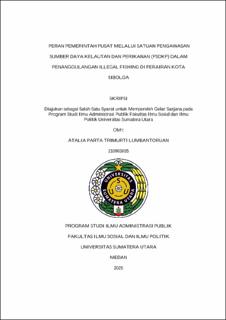| dc.description.abstract | Illegal fishing in the waters of Sibolga City not only damages the marine ecosystem but also threatens the economic sustainability of traditional fishing communities. This study aims to analyze the role of the central government through the Marine and Fisheries Resources Surveillance Unit (Satuan Pengawasan Sumber Daya Kelautan dan Perikanan/PSDKP) Sibolga in tackling illegal fishing, based on Ryaas Rasyid’s theory of governmental roles, which includes the functions of regulator, dynamizer, and facilitator. A descriptive qualitative approach was used, with data collected through in-depth interviews and document analysis, including annual reports, regulations, and operational data from PSDKP between 2021 and 2024.
The findings show that as a regulator, PSDKP implements policies under Law No. 45 of 2009 and operates the Fisheries Monitoring System (Sistem Pemantauan Kapal Perikanan/SPKP) and the Vessel Monitoring System (VMS), though effectiveness is limited by a lack of patrol vessels, personnel, and inter-agency coordination. As a dynamizer, PSDKP conducts public outreach and has established Community Surveillance Groups (POKMASWAS), but public participation remains low due to mistrust and underdeveloped reporting mechanisms. As a facilitator, PSDKP provides eco-friendly fishing gear and builds infrastructure such as fish auction centers (/TPI) and fishing ports, though distribution and utilization remain suboptimal.
The study concludes that although the central government has structurally fulfilled its roles, implementation still faces technical and institutional barriers. It recommends strengthening PSDKP’s institutional capacity through increased patrol assets and personnel, higher operational budgets, integration of real-time surveillance technology such as the Automatic Identification System (AIS), and reforms to sanctions and reporting systems. These efforts are expected to support the development of an adaptive, collaborative, and sustainable marine monitoring system. | en_US |


